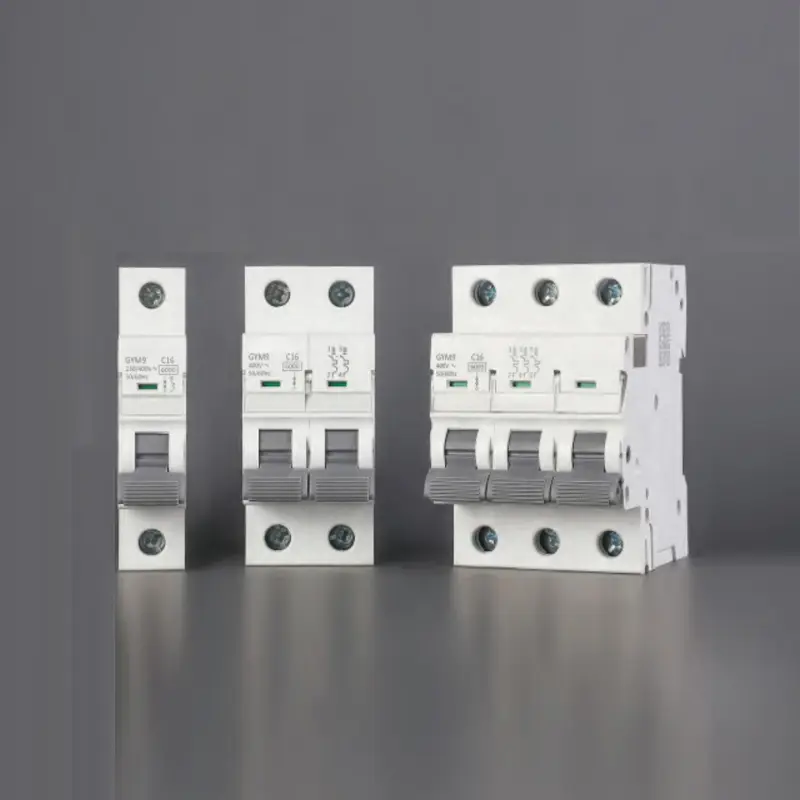Click to view Circuit Breaker Guide Part Two
I. Understanding the Basic Functions of Circuit Breakers
1.1 Protecting Circuits from Overload and Short‑Circuit Damage
Circuit breakers protect circuits from overheating and fire. Overload happens when current exceeds the circuit’s safe limit. Wiring heats up, and fire risks increase. Short circuits occur when current bypasses its intended path due to damaged insulation or incorrect connections. These events generate extremely high currents and heat in fractions of a second. Circuit breakers must detect such faults quickly and disconnect power to safeguard both equipment and people.
Thermal-magnetic breakers combine two detection methods. A thermal element reacts to moderate overloads. A magnetic component responds instantly to high fault currents. Together, they trip effectively in both scenarios. Always select breakers with proper rated current and voltage to ensure appropriate protection. For example, a 20 A breaker trips when current exceeds 20 A for a set time. Choose also a breaker with sufficient breaking capacity—e.g., 10 kA—to handle short-circuit events. Correct selection ensures reliable and safe operation in power systems.
1.2 The Role and Importance of Circuit Breakers in Circuits
Circuit breakers serve as electrical guardians. They cut power during abnormal current events, preventing fires and protecting devices. According to the NFPA, electrical faults rank high among residential fire causes. Proper breaker use significantly lowers this risk. They also extend equipment life. In industry, reliable breakers mean uninterrupted production and safe operations. Appropriate selection ensures power-system stability.
II. Types and Characteristics of Circuit Breakers
2.1 Thermal‑Magnetic Circuit Breakers: Principle and Use
Thermal-magnetic breakers offer dual protection. A bimetal strip senses sustained overloads and bends with heat, triggering a trip. When a fault causes high current, a magnetic coil acts instantly to open the circuit. IEC standards require these breakers withstand 1.45× rated current for 1 hour without tripping. They must trip quickly at roughly 6× rated current. These conditions ensure they trip only when needed. As Edison said, “Safety first, prevention is better than cure.”
2.2 Electronic Circuit Breakers: Advantages and Applications
Electronic breakers offer precise and fast protection. They detect abnormal currents within milliseconds. You can program them to match protection needs. These features suit modern environments like data centers, hospitals, smart homes, and industrial automation. In data centers, they help maintain uptime; in healthcare, they ensure power safety; in smart homes, they integrate with automation systems. Nikola Tesla observed that combining science and art leads to the future. These breakers embody that vision in electrical safety.
III. Rated Parameters of Circuit Breakers
3.1 Determining Rated Current and Voltage
Rated current defines how much continuous load a breaker can handle safely. Rated voltage defines the maximum voltage it can block. For a 15 A circuit, choose a breaker slightly above 15 A—adding a 25% margin per NEC—to prevent nuisance trips. Match rated voltage to your supply. In complex industrial systems, consider load peaks and startup surges. Use scientific calculations to ensure both safety and efficiency.
3.2 Breaking Capacity and How to Choose
Breaking capacity measures a breaker’s ability to interrupt fault currents. A 6 kA breaker can safely stop 6000 A. When a circuit might experience up to 5 kA short-circuit current, choose a breaker rated at least 6 kA. Also ensure the breaker fits your current and voltage needs. Tesla said safety guides system design. Always prioritize standards compliance—such as IEC or UL certifications—to guarantee quality.
IV. Safety Standards and Certifications
4.1 Key International and Local Standards
Safety standards guide safe breaker design. IEC 60898-1 governs residential breakers worldwide. In China, GB 10963.1 sets voltage, current, and breaking capacity rules. CE and UL marks signal that a breaker meets required safety and quality tests. Following standards ensures compatibility and reliability. Edison reminded us that “prevention is better than cure.” Standard compliance protects systems from accidents.
4.2 Certification Marks Ensure Quality and Trust
Certification verifies product quality. IEC, UL, and CE standards ensure electrical performance, thermal stability, and impact resistance. For example, a UL 489 breaker undergoes rigorous testing to guarantee safe operation under extreme conditions. Tesla said quality must be built into a product. Choose breakers with recognized certification to ensure reliability and long-term performance.
Summary of Part One
This section deep-dived into circuit breaker essentials:
-
Defined their role in overload and short-circuit protection
-
Explained thermal-magnetic vs. electronic types
-
Clarified how to select rated current, voltage and breaking capacity
-
Emphasized international safety standards and certification importance
Apply these insights to ensure your electrical system operates safely and effectively. Need help selecting or installing breakers? We’re here to support you.

